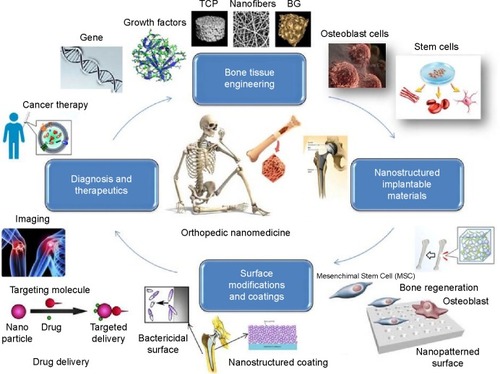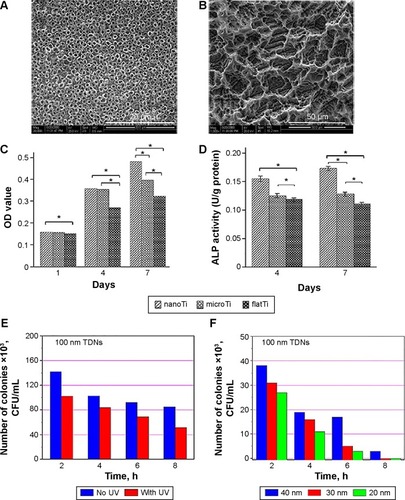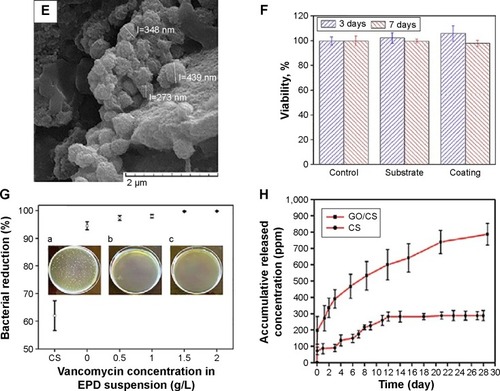Figures & data
Figure 1 Scheme shows potential applications of nanomedicine in orthopedic medicine.
Abbreviations: BG, bioactive glass; TCP, tricalcium phosphate.

Table 1 Typical materials used in orthopedics, including nanostructures
Figure 2 Effects of surface nanostructuring on the cell viability, differentiation, and bactericidal capacity of CP Ti.
Notes: (A, B) SEM images of TiO2 nanotube layer and microporous titanium, respectively. (C, D) The nanostructuring effect on the MG-63 cell proliferation and ALP activity. Reproduced with permission of Dove Medical Press, from Xia L, Feng B, Wang P, et al. In vitro and in vivo studies of surface-structured implants for bone formation. Int J Nanomedicine. 2012;7:4873; permission conveyed through Copyright Clearance Center, Inc.Citation35 Antibacterial activity of TiO2 nanotubes. *P<0.05, n=9; . *P<0.05, n=7. (E) under UV radiation and (F) in the presence of silver NPs of different sizes. Copyright © 2014. John Wiley & Sons, Inc. Reproduced from Esfandiari N, Simchi A, Bagheri R. Size tuning of Ag-decorated TiO2 nanotube arrays for improved bactericidal capacity of orthopedic implants. J Biomed Mater Res A. 2014;102(8):2625–2635.Citation41
Abbreviations: CP, commercially pure; SEM, scanning electron microscope; ALP, alkaline phosphatase; UV, ultraviolet; NPs, nanoparticles; h, hours; TDN, titanium dioxide nanotubes.

Table 2 Surface modification methods for titanium and its alloys implants
Figure 3 Effect of carbon nanostructures on the performance of electrodeposited polysaccharide coatings on Ti foils.
Notes: (A) SEM image of CS/GO (30 wt%) coating.Citation113 (B) MTT viability and (C) SEM morphology of MG-63 cells cultured on the surface of the CS/GO coating. (D) A SEM image of alginate/BG/ND film. Copyright © 2013. Elsevier B.V. Reproduced from Mansoorianfar M, Shokrgozag MA, Mehrjoo M, Tamjid E, Simchi A. Nanodiamonds for surface engineering of orthopedic implants: enhanced biocompatibility in human osteosarcoma cell culture. Diam Relat Mater. 2013;40(0):107–114.Citation53 (E) Formation of apatite phases on the surface of the alginate coating after 28 days of incubation in the SBF and (F) its MG-63 cell viability response. (G) The antibacterial performance of the CS/GO coating containing vancomycin against Staphylococcus aureus. Insets: plate counting images showing S. aureus bacteria colonies after 120 min incubation for the CS-30GO film containing (a) 0, (b) 0.5 and (c) 1 g/l antibiotics. (H) Cumulative drug release of the CS/GO (30 wt%) coating. Copyright © 2015. Elsevier B.V. Reproduced from Ordikhani F, Ramezani Farani M, et al. Physicochemical and biological properties of electrodeposited graphene oxide/chitosan films with drug-eluting capacity. Carbon. 2015;84(0):91–102.Citation113 *Denotes significant difference between TPS and EPD coatings (P<0.05). #Denotes significant difference between CS and composite coatings (P<0.05).
Abbreviations: SEM, scanning electron microscope; CS, chitosan; GO, graphene oxide; BG, bioactive glass; ND, nanodiamond; SBF, simulated body fluid; TPS, tissue culture polystyrene; EPD, electrophoretic deposition; MTT, 3-(4,5-Dimethylthiazol-2-Yl)-2,5-Diphenyltetrazolium Bromide.


